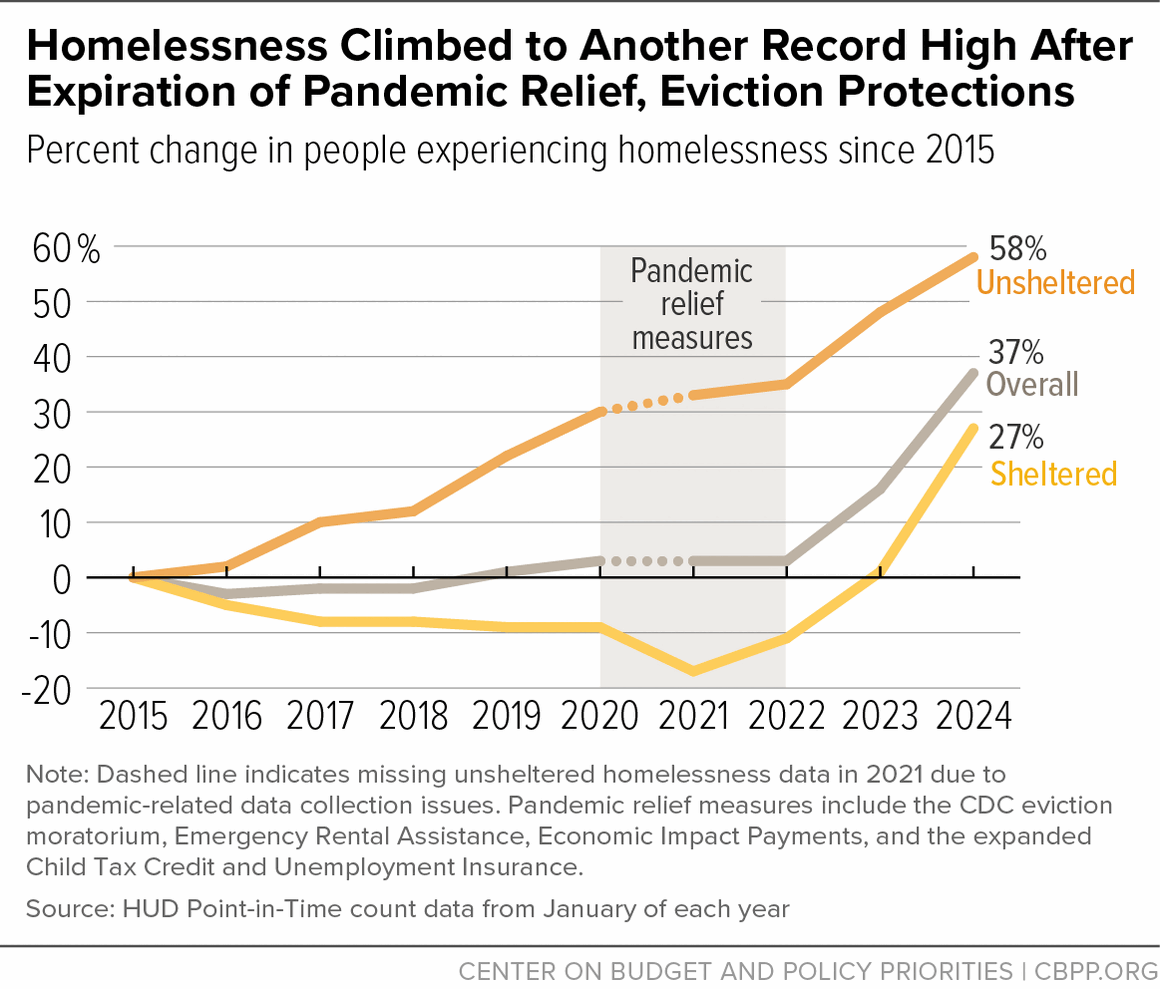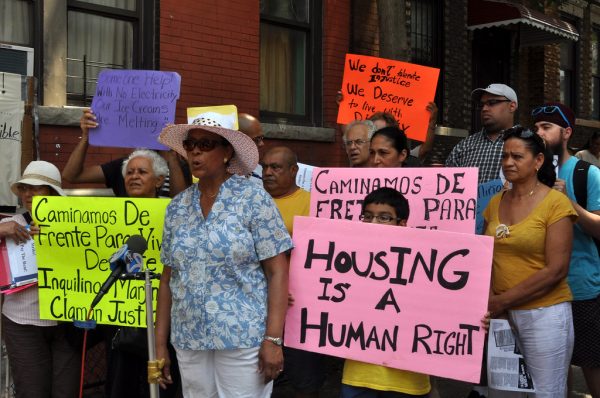Homelessness has risen sharply since 2023, new data show. The research is clear: rental assistance promotes housing stability and is key to solving homelessness. Reducing, and ultimately solving, homelessness will require expanding rental assistance and access to supportive services. Unfortunately, President-elect Trump’s record and Republican proposals raise concerns that the incoming Administration and Congress could abandon evidence-based approaches; cut funding for programs like rental assistance, increasing the already large number of households who don’t receive help because of inadequate resources; and pursue policies that will further increase homelessness and housing instability and deepen inequities.
New data released in late December by the Department of Housing and Urban Development (HUD) show that homelessness was 18 percent higher in January 2024 than the same time last year, reaching an all-time high for the second year in a row. Homelessness increased among families with children, single adults, youth, and people experiencing chronic (long-term or repeated) homelessness — every household type except for veterans.
Affordable housing is a basic human need. We know a lot about how to make housing affordable and accessible for people with low incomes, including people experiencing homelessness. But those evidence-based solutions, like rental assistance, remain underfunded, and homelessness and cost burden among renters have reached unprecedented levels. This is a policy choice. In the wealthiest nation in the world, solutions are in reach.
The gap between incomes and rents is primarily driving homelessness and housing instability. For decades, the cost of rent has outpaced renters’ incomes. About 8.5 million households with very low incomes who receive no housing assistance spent more than half their income on rent or lived in severely inadequate housing in 2021. Many of these households are forced to choose each month between paying rent and having enough to buy food or meet other basic needs, while others are forced to live in shelters, cars, tents, and other unstable and often unsafe locations.
Deep racial and other inequities in homelessness and housing insecurity persist, due to income and wealth inequities stemming from generations of discrimination in housing, education, and employment. For example, Black people made up 12 percent of the total U.S. population but were 32 percent of all people experiencing homelessness in 2023. Native Hawaiian and Pacific Islanders, American Indian and Alaska Natives, and Latine people also experience disproportionately high rates of homelessness.
Rental assistance and voluntary, individualized supportive services are highly effective at resolving homelessness. This approach has been instrumental in cutting veteran homelessness in half — and functionally ending veteran homelessness in 85 communities and three states — because lawmakers have scaled up funding for rental assistance and voluntary services for veterans experiencing homelessness. These resources should be available to everyone experiencing homelessness, but federal lawmakers have long underfunded rental assistance — only 1 in 4 eligible households receives it.
The early years of the pandemic also offer examples of what works to stem increases in homelessness and reduce poverty. Crisis-related income and rental assistance dramatically reduced poverty — including cutting child poverty in half — and helped many people stay housed. But that pandemic assistance has largely ended, leaving in its wake back-to-back years of record-breaking spikes in homelessness.

Unmet needs grow even more severe when recessions, surges in market rents, natural disasters, or other factors cause the number of people who can’t afford housing to rise. For example, in some communities, some people who recently came to the U.S. seeking asylum or opportunity were left with nowhere to stay while awaiting work permits. If communities had resources that matched need, they would have been better positioned to help newcomers get on their feet. Instead, due to policymakers’ choices, the inadequate support for newcomers in some communities likely contributed to recent increases in HUD’s homelessness count. We can solve and prevent homelessness for everyone and should reject policies that pit groups of unhoused people against each other.
We can’t predict what will unfold during the incoming Trump Administration’s second term and the current Congress, but policymakers should reject budget cuts and cruel policies like those proposed by the first Trump Administration, Heritage Foundation’s Project 2025, the House Republican Study Committee’s (RSC) budget, and a funding bill passed by Republicans on the House Appropriations Committee this year. These proposals would:
- Severely cut funding for homelessness assistance, housing vouchers, and other HUD programs, including a cut to housing vouchers in the House funding bill that would leave hundreds of thousands of people without assistance if policymakers don’t provide adequate funding when they finalize 2025 appropriations in the coming months.
- Raise rents on tenants with low incomes, forcing them to divert resources from other basic needs to avoid eviction or homelessness.
- Take assistance away from struggling households for not meeting harsh, inflexible, and red tape-laden work requirements, increasing their risk of homelessness and other hardship and doing nothing to help people access better paying jobs.
- Abandon humane and evidence-based responses to homelessness in favor of cruel and short-sighted measures, such as encouraging jurisdictions to arrest people for sleeping outside when they have nowhere else safe to stay.
- Attack fair housing opportunities for everyone regardless of their race, color, gender, nationality, disability status, religion, or whether they have children, making it harder for households to access housing.
- Force eligible people receiving rental assistance to break up their families or lose rental assistance if they live in a “mixed-status” family in which at least one person in the household doesn’t have an eligible immigration status.
- Allow discrimination against transgender and nonbinary people in homeless shelters.
States and localities undertake their own efforts — including rental assistance programs, tenant protections, and voluntary supportive services — to improve access to affordable housing, reduce homelessness, and mitigate harm that may come from misguided federal policies. They can fund these programs in a variety of ways, including through progressive real estate taxes, such as taxing very high-value properties (also known as “mansion taxes).
But state and local efforts aren’t enough on their own — states and localities can only rehouse a fraction of unhoused people without more federal funding. Federal policymakers should at least maintain existing assistance levels in the face of proposed cuts and reject cruel and ineffective policy proposals. Better yet, they should enact reforms to make rental assistance work better for tenants and expand rental assistance, building toward a rental assistance guarantee, to bridge the gap too many renters experience between their incomes and rent costs.

No comments:
Post a Comment